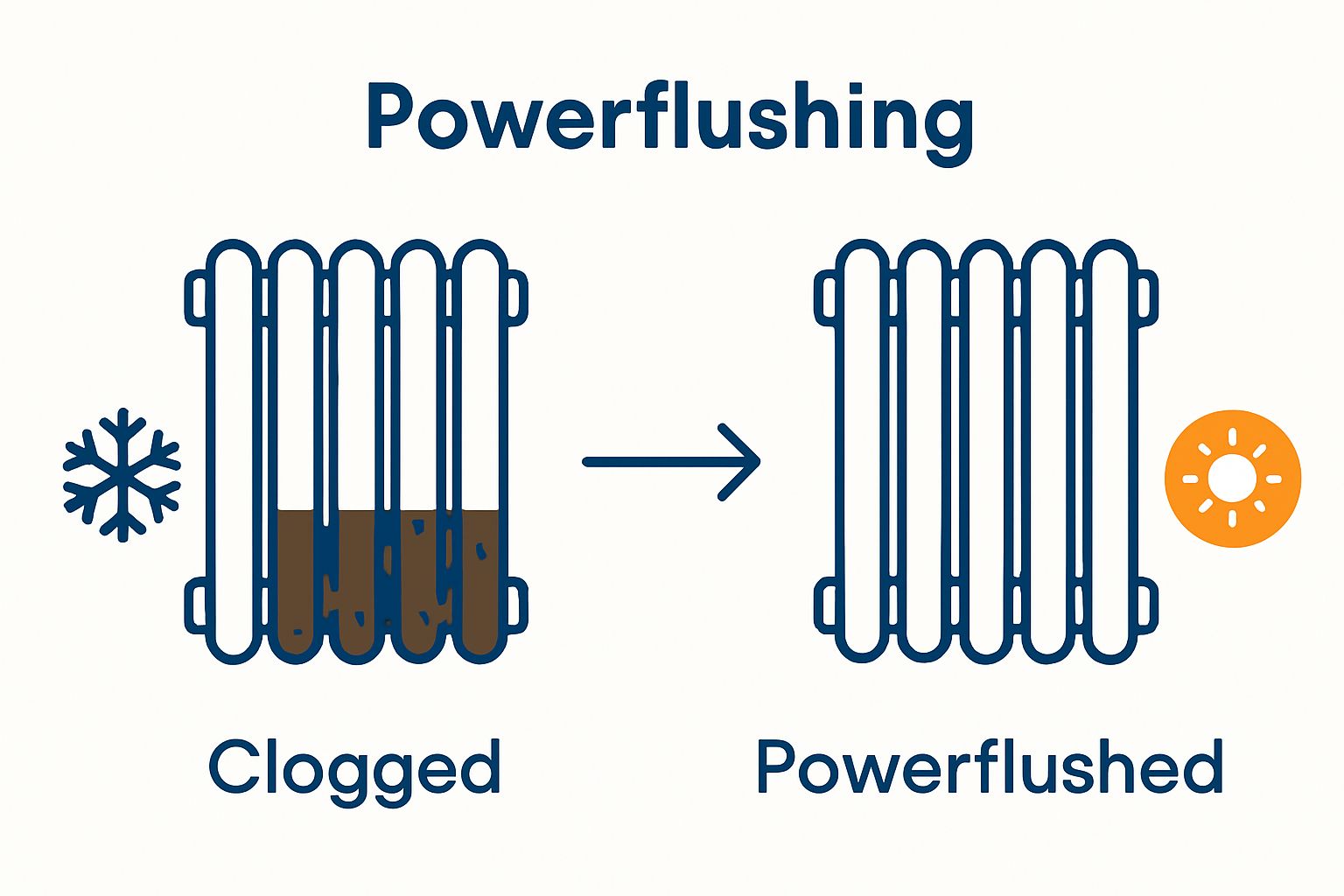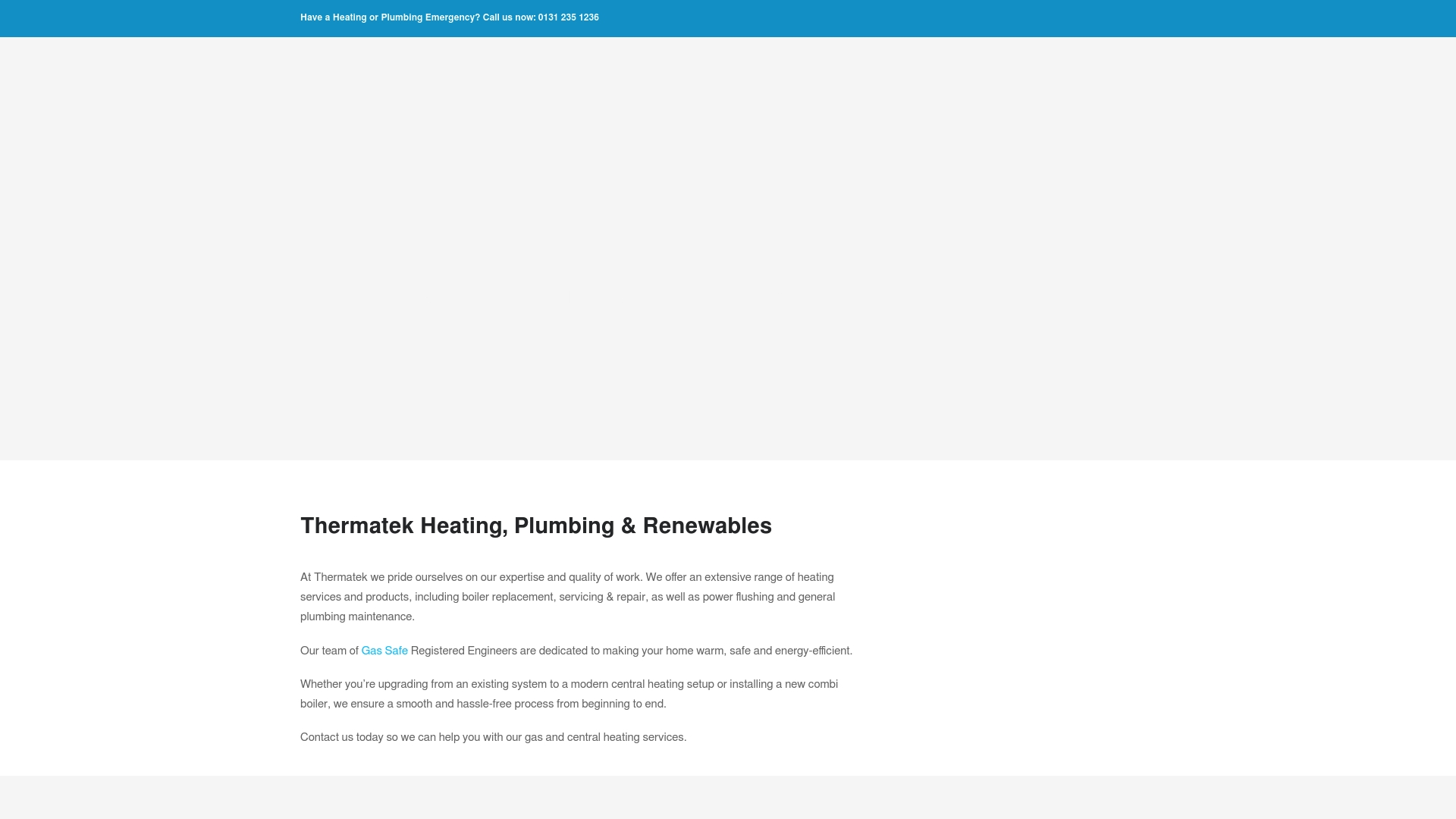Do I Need a Powerflush? Understanding Your Heating System
Central heating keeps homes warm and comfortable year-round, but hidden inside the pipework trouble can quietly build up. It might sound harmless, yet debris and sludge can slash system efficiency by up to 15 percent and even double your energy bills over time. Most people think a new boiler is the answer, but a professional powerflush could bring your entire system back to life without the cost or hassle of major replacements.
Table of Contents
- What Is A Powerflush And When Is It Necessary?
- Why Powerflushing Is Important For Home Heating Systems
- How Powerflushing Works: The Process Explained
- Signs That Your System Might Need A Powerflush
- Understanding The Benefits And Costs Of Powerflushing
Quick Summary
| Takeaway | Explanation |
|---|---|
| Powerflushing maintains heating efficiency | Regular powerflushing removes sludge and debris, enhancing your system’s performance and preventing inefficiencies. |
| Watch for signs needing powerflush | Indicators include cold radiator bottoms, increased energy bills, and noisy boilers, signalling the need for immediate maintenance. |
| Powerflushing can save on energy costs | Investing in powerflushing can lead to energy bill reductions of up to 15%, delivering long-term savings. |
| Delay in powerflush leads to higher repair costs | Neglecting powerflush can result in costly breakdowns and increased wear on components, necessitating early intervention. |
| Professional powerflushing is essential | Skilled engineers use specialised equipment and cleaning solutions to ensure thorough system restoration and efficiency. |
What is a Powerflush and When is it Necessary?
A powerflush represents a critical maintenance procedure for central heating systems designed to remove accumulated debris, sludge, and rust that naturally builds up inside radiators and pipework over time. Powerflush services in Edinburgh can dramatically improve your heating system’s efficiency and prevent potential long-term damage.
Understanding System Buildup
Central heating systems gradually accumulate sediment through natural corrosion processes. Metal components within pipes and radiators slowly deteriorate, creating magnetic and non-magnetic particles that circulate through your system. These particles can cause significant problems if left unchecked
 :
:
- Reduced heating efficiency
- Cold spots in radiators
- Increased energy consumption
- Potential damage to boiler components
Signs You Need a Powerflush
Recognising when a powerflush becomes necessary involves understanding specific warning signals from your heating system. According to Which? Home and Heating Experts, several indicators suggest your system might require professional intervention:
- Radiators that are cold at the bottom but warm at the top
- Noisy boiler or central heating pump
- Discoloured water when bleeding radiators
- Frequent breakdowns of heating equipment
- Significantly higher energy bills without apparent reason
Powerflushing involves using specialized equipment to forcefully circulate cleaning chemicals through your entire heating system.
Below is a table summarising key warning signs that indicate your heating system may require a powerflush, helping homeowners spot issues before costly breakdowns occur.
| Warning Sign | Description |
|---|---|
| Cold radiators at the bottom | Indicates sludge buildup blocking heat transfer |
| Noisy boiler or central heating pump | Suggests internal debris causing turbulence |
| Discoloured water when bleeding radiators | Reveals corrosion or rust contamination within the system |
| Frequent breakdowns of heating equipment | Accumulated debris placing strain on components |
| Significantly higher energy bills | Efficiency reduction leading to increased energy use |
By addressing system buildup proactively, homeowners can prevent costly repairs and maintain optimal heating performance throughout their property.
Why Powerflushing is Important for Home Heating Systems
Powerflushing plays a crucial role in maintaining the health and efficiency of central heating systems, preventing potential catastrophic failures and ensuring optimal performance. Understanding hydronic heating systems provides context for why regular maintenance becomes essential for long term system reliability.
The Hidden Dangers of System Debris
Over time, central heating systems accumulate a complex mixture of corrosion byproducts, sludge, and microscopic metal particles. These contaminants create significant risks to your heating infrastructure. According to research from the Energy Saving Trust, untreated system debris can lead to multiple performance and efficiency problems:
- Reduced heat transfer efficiency
- Increased energy consumption
- Accelerated component wear
- Potential complete system breakdown
Economic and Performance Implications
The economic impact of neglecting powerflush maintenance extends far beyond immediate repair costs. Heating systems compromised by internal debris work significantly harder to maintain desired temperatures, resulting in substantially higher energy expenditure. Professional assessments indicate that systems with moderate buildup can experience efficiency reductions of up to 15%, translating into increased annual heating expenses.
Moreover, accumulated debris creates additional strain on critical components like boiler pumps and heat exchangers. This extra mechanical stress dramatically shortens equipment lifespan, potentially necessitating expensive replacements years before their expected operational period. By investing in regular powerflushing, homeowners can protect their heating infrastructure, maintain system efficiency, and avoid unexpected and costly repair interventions.
Powerflushing represents a proactive maintenance strategy that safeguards your home’s heating performance, ensures consistent thermal comfort, and delivers substantial long-term financial benefits through improved system reliability and energy efficiency.
How Powerflushing Works: The Process Explained
Powerflushing represents a sophisticated cleaning technique designed to restore central heating systems to their optimal performance. How to flush heating systems in Edinburgh homes provides insight into the localized approach professionals use to address system contamination.
The Technical Mechanics of Powerflushing
The powerflush process involves a series of precisely engineered steps that systematically remove accumulated debris from your heating infrastructure.
This table outlines the typical steps involved in the professional powerflushing process, clarifying the technical approach for restoring system efficiency.
| Step | Description |
|---|---|
| High-pressure water circulation | Forces debris through and out of the system |
| Introduction of chemical cleaning agents | Breaks down sludge, corrosion, and mineral deposits |
| Magnetic filtration | Captures and removes metallic contaminants |
| Comprehensive system flushing | Removes loosened debris and cleaning solution from the system |
| Neutralisation | Balances pH and ensures safety for ongoing system operation |
- High-pressure water circulation through the entire heating network
- Introduction of specialized chemical cleaning agents
- Magnetic filtration to capture metallic contaminants
- Comprehensive system flushing and neutralization
Comprehensive Cleaning and Treatment
Professional engineers employ advanced machinery specifically designed to generate substantial water pressure and volume. This equipment connects directly to your heating system, creating a powerful cleaning mechanism that dislodges years of accumulated sludge, rust, and corrosion byproducts. The cleaning solution used during powerflushing contains carefully formulated chemicals that break down mineral deposits and prevent future corrosion.
The process involves multiple directional water flows that ensure thorough cleaning of every radiator, pipe, and system component. Technicians monitor water color and clarity throughout the procedure, which serves as a real-time indicator of debris removal progress. Magnetic filters integrated into the process capture metallic particles, preventing their recirculation and potential damage to critical heating infrastructure.
By systematically removing contaminants, powerflushing restores your heating system’s efficiency, reduces energy consumption, and extends the operational lifespan of expensive components like boilers and heat exchangers.
Signs That Your System Might Need a Powerflush
Detecting early warning signs of heating system deterioration can prevent costly repairs and extend your infrastructure’s operational lifespan. What is power flushing and its importance offers additional context for understanding these critical indicators.
Performance Degradation Indicators
Heating systems communicate their health through subtle yet significant performance changes. According to British Heating Research Council, homeowners should pay close attention to several key performance signals:
- Radiators that are cold at the bottom but warm at the top
- Significantly increased heating times
- Inconsistent heating across different rooms
- Unusual noises from boiler or radiators
- Reduced overall heating efficiency
Physical Evidence of System Contamination
Visual and tactile indicators provide direct evidence of internal system deterioration. Discoloured water when bleeding radiators represents a critical warning sign of excessive internal corrosion. Professional heating engineers recognize these symptoms as clear indications that accumulated debris has reached problematic levels.
Economic considerations also play a crucial role in identifying powerflush necessity. Systems experiencing substantial debris buildup work significantly harder to maintain desired temperatures, resulting in dramatically increased energy consumption. Homeowners might notice unexplained spikes in heating bills despite unchanged usage patterns, which often signals underlying system inefficiencies requiring professional intervention.

By recognizing these warning signs early, property owners can proactively address potential heating system complications, preventing more extensive and expensive damage while maintaining optimal thermal comfort and energy efficiency.
Understanding the Benefits and Costs of Powerflushing
Powerflushing represents a strategic investment in your heating system’s long-term performance and efficiency. Complete hot water cylinder maintenance provides additional context for understanding comprehensive heating system care.
Long-Term Financial Benefits
While initial powerflush costs might seem substantial, the long-term financial advantages are significant. According to Energy Saving Trust research, professional powerflush treatments can deliver measurable economic benefits:
- Potential energy bill reductions of up to 15%
- Extended heating system lifespan
- Reduced risk of expensive component replacements
- Lower maintenance and repair costs
- Improved overall system efficiency
Cost Considerations and Investment Analysis
The average powerflush cost typically ranges between £300 and £750, depending on system complexity and property size. Professional heating engineers evaluate multiple factors when determining precise pricing, including:
- Total number of radiators
- System age and current condition
- Accessibility of heating infrastructure
- Potential complexity of debris removal
- Required specialized cleaning equipment
The economic rationale extends beyond immediate expense. By preventing potential boiler breakdowns and reducing energy consumption, powerflushing offers a compelling return on investment.
The following table breaks down the main financial and performance benefits of powerflushing as described in the article, aiding homeowners in evaluating its return on investment.
| Benefit | Explanation |
|---|---|
| Energy bill reduction (up to 15%) | Improved efficiency means less energy needed for heating |
| Extended system lifespan | Reduced strain on components delays need for replacements |
| Lower repair and maintenance costs | Prevents breakdowns linked to sludge and debris |
| Improved heating efficiency | Restores optimal heat transfer and system performance |
| Reduced risk of expensive failures | Proactive cleaning minimises likelihood of major component damage |
Ultimately, powerflushing represents a proactive maintenance strategy that balances immediate investment against substantial long-term financial and performance benefits for your home’s heating infrastructure.
Restore Your Heating Efficiency and Comfort – Expert Help Is Here
Is your heating system suffering from cold spots, rising energy bills, or noisy radiators? If your home is showing signs mentioned in our article, such as discoloured water from the radiators or uneven heating, a professional powerflush could be the solution your system urgently needs. At Thermatek Heating, our experienced Gas Safe Registered engineers bring advanced skills and proven results to every powerflush we carry out. This is your opportunity to reclaim reliable warmth, reduce costly repairs, and make your home energy bills more manageable.

Do not let unresolved sludge or corrosion put your comfort and investment at risk. Act now to protect your heating system and enjoy peace of mind throughout the colder months. Visit Thermatek Heating to arrange your powerflush or get a free, no-obligation quote today. Take the next step towards efficient, worry-free heating.
Frequently Asked Questions
Do I need a powerflush for my heating system?
Yes, you may need a powerflush if you notice cold spots in your radiators, unusual noises from your boiler, or discoloured water when bleeding your radiators. To determine if a powerflush is necessary, check for these indicators and consider having a professional assess your system’s condition.
How often should I consider a powerflush?
It is generally recommended to consider a powerflush every 5 to 10 years, depending on your system’s condition and performance. Regularly monitor for signs of buildup or inefficiency to decide the best timing for a powerflush.
What are the signs that my heating system needs a powerflush?
Look for signs such as cold radiators at the bottom, increased heating times, or higher energy bills without a change in usage. If you notice these symptoms, schedule a professional evaluation to discuss the possibility of a powerflush.
How does the powerflush process work?
The powerflush process involves using high-pressure water and specialised cleaning agents to remove sludge and debris from your heating system. To understand the procedure better, consult with a professional who can explain the steps and equipment used during a powerflush.
Will a powerflush improve my heating efficiency?
Yes, a powerflush can significantly improve your heating system’s efficiency by removing debris that hinders heat transfer. To maximise your heating performance, consider scheduling a powerflush when you observe any indicators of system issues.
What is the average cost of a powerflush?
The average cost of a powerflush typically ranges from £300 to £750, depending on the size and complexity of your heating system. To get an accurate estimate, contact a professional for a tailored assessment based on your specific system needs.

